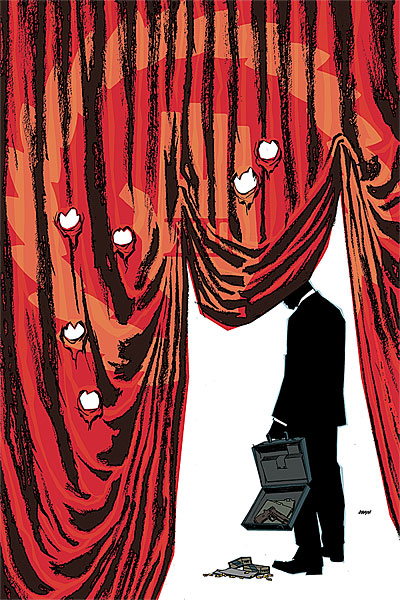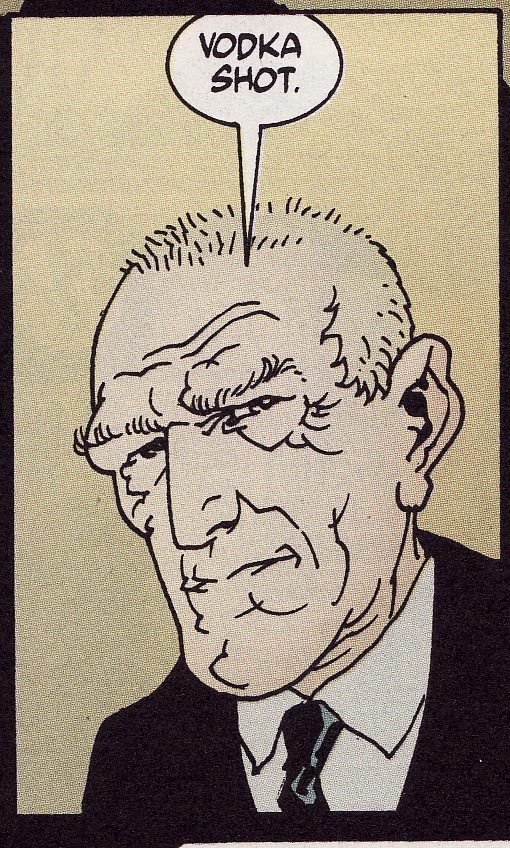Grave Consequences: The End of 100 Bullets
/
This week, a much-beloved, oft-delayed series came to its highly anticipated conclusion. I’m talking, of course, about Halo: Uprising…nah, just kidding. Instead of wasting time talking about a four-issue miniseries that took about two years to come out, I’m going to celebrate and eulogize a 100-issue miniseries that came out more or less regularly over the last ten years, with a few production holdups along the way (around the middle and at the end, mostly). Brian Azzarello and Eduardo Risso, take a much-deserved bow—you guys finally reached the end of 100 Bullets.

This is somewhat surprising, since it looked as though the Vertigo revenge drama wouldn’t survive its first year. I gave the first issue a glance when it came out—liked the art, dug the cover, appreciated the pacing and street-smart dialogue—but there wasn’t enough there to bring me back for issue two. The concept, a semi-anthology where the mysterious Agent Graves offers consequence-free revenge to a series of hard luck cases, had promise, but…I don’t know. There just wasn’t enough meat on its metaphorical bones, so to speak. However, by the time the first collection, First Shot Last Call, arrived, with its dirt-cheap price tag—ten bucks US for five issues and a short story, not bad!—I had heard the growing buzz and decided to give 100 Bullets another try. This formula succeeded in spades, as the low price point and critical acclaim made it an irresistible draw. The title continued, racking up awards, acclaim, and increased sales, and a Vertigo sales strategy that continues to this day was born. As for me, I was in for the long haul.
The second 100 Bullets collection, Split Second Chance, is where lots of readers who weren’t entirely swayed by the first book toppled altogether. It’s in this much longer trade that we get our first glimpses of the bigger conspiracy behind Agent Graves’ “game”--that he is not only doling out sweet, sweet revenge, but that he is recruiting new players into an older, much more dangerous game. It’s where we see that Azzarello is not only a pro at crafting multi-part stories, but killer one-shots as well (such as “Heartbreak, Sunny Side Up”, still one of the all time greats). It’s where we begin to chart the evolution of Chicago gang-banger Dizzy Cordova, heroine of the series’ introductory arc, as she is crafted into Graves’ greatest weapon, and where we meet the first of the mysterious and deadly Minutemen, like savage Lono and slick Cole Burns. Finally, it’s where we hear the first whispers about the Trust, the sinister cabal of families who control everything that’s worth controlling in America.
I should pause here and talk about Eduardo Risso’s art. It would be impressive enough to note that the Argentinean illustrator didn’t even meet his collaborator until well into the series’ run, and in fact, had to have the scripts translated for him because he didn’t understand English—furthermore, he wasn’t even on the same continent as the writer! All of that is beside the point, when you see how brilliantly Risso brings the stories to life. Not only does he capture all the raw emotion, all of the gun-blazing action, all of the oh-so-important character subtleties, but he populates every panel with the most bizarre-looking, eye-catching background characters this side of a Dick Tracy strip to boot. It’s hard to say which angles or details are in the script and which ones Risso concocts himself, but come on—this guy gives you shots from inside a pinball game, from a canvas about to be painted on, and from behind a man’s skull as his brains are being blown out! You gotta stand up and salute that kind of vision. And he only gets better as the series goes along.

I also have to mention Dave Johnson’s artistic contribution, providing the striking cover imagery of all 100 issues and all 13 (eventual) collected editions. Even in the early days of his more traditional painted covers, Johnson’s work had the eye-catching quality of some of the cooler movie posters from the 60s and 70s, but over time his arrangements became more daring and unconventional, all the while looking completely effortless. This is, I think, a case where the use of PhotoShop has made a great artist even better, opening up new possibilities and firing his imagination rather than simply making him lazy. Strange Adventures bossman Calum Johnston scored an amazing Agent Graves sketch for me from the man himself in Toronto a few years back, and it’s scowling down at me as I type this.
100 Bullets is one of those series that, while obviously successful enough to continue all the way to its planned conclusion, never sold lots of copies of the single issues. That’s why that first trade was such an important component in its early success—the long-range planning Azzarello put into the book was much more evident when you read it that way. This is the kind of title, after all, where someone appears for a few panels in the background of an issue, only to become a central figure two or three trade paperbacks down the line. This is a series that rewards patience and attention to detail, which could often make the monthly comics confusing and occasionally tedious. I re-read all twelve existing trades before the final arc began, then began reading the monthlies to see it though to the end, but by about four or five issues into it, I realized I was already getting lost in the wait between issues.
Which brings me, finally, to 100 Bullets #100. This super-sized issue features Graves’ final showdown with the remaining members of the Trust, while the remaining members of the Minutemen cause grievous bodily harm to countless bodyguards and each other. If that synopsis sounds a bit pedestrian, it’s because, as predicted…I mostly had no idea what the hell was going on. There were definitely some memorable moments, like Jack Daw vs. hulking bodyguard Crete vs. a bunch of alligators, and Cole Burns’, er, heated exchange with ice queen Megan Dietrich, but I couldn’t wrap my head around what exactly all of Graves’ Byzantine maneuvering had actually accomplished, and what it meant for the final scene (which, appropriately enough, came down to Graves and Dizzy). It sure did look great, though, but I think I’ll appreciate it a lot more when I revisit it in the final trade (due out this summer).
Still, sometimes the ride is the point, not the destination, and 100 Bullets was a ride like no other. One of the sexiest, goriest, most intricately plotted and beautifully drawn comics I’ve ever read, populated with some of the most memorable psychopaths, femmes fatales, smooth operators, and sad sacks ever found between two covers, has come and gone, and I can’t imagine what could replace it or even want to try.

Have one on me, Graves, you've earned it. Now who the hell’s gonna sweep up all these shell casings?





